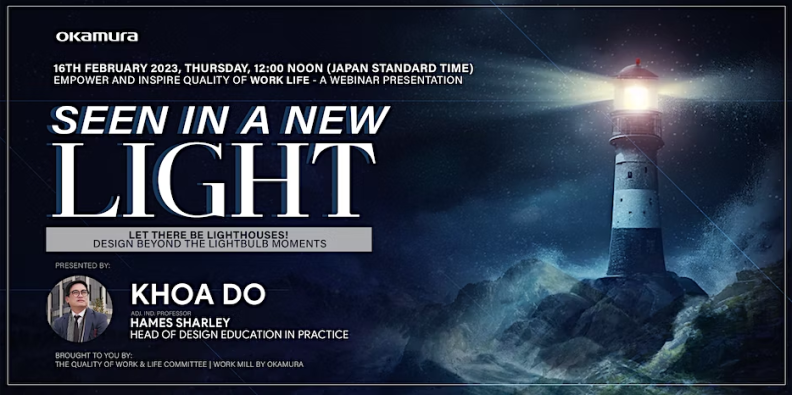
Hames Sharley’s Head of Design Education in Practice, Professor Khoa Do, will be presenting a live webinar from Tokyo, Japan as part of Okamura’s ‘Empower and Inspire Quality of Work Life’ seminar on 16 February.
The session called ‘Seen in a New Light’ is a call to empower designers to lead others on the journey of discovery, rather than bear the burden of ideation in isolation.
Our environment poses a formidable force for today’s designers – a space where challenges are fluid, complex and far-reaching. However, our environment is also shared by a range of communities bound by the very challenges the designer is looking to solve. That’s where the role of the designer can really thrive.
By breaking with conventional boundaries, designers can become a ‘lighthouse’ – a facilitator that empowers others on a shared creative journey of discovery. Our world consists of multiple layers of communities at any one time that is bound by a common challenge or goal. Designers have an opportunity to rally these communities and empower them to co-create with designers, rather than ask designers to ideate in isolation.
As part of this session, Professor Khoa will unpack what it truly means for designers to be that lighthouse for their communities:
- DESIGN: Designers today and into the near and far futures are not your traditional seekers of lightbulb moments, but instead, they are an emerging breed of designers driven by a sense of belonging to a progressively futurist design fraternity. They are proficient collaborators with data-driven, methodical, systematic thinking and thoughtful human-centred design. They are characterised as possessing the ability to illuminate new pathways in turbulent conditions, typifying lighthouse qualities 2. They seek their luminosity in the service of others with an incontrovertible moral pursuit of solutional sensibility.
- CONTEXT: Our world is facing tremendous strain and tension from the uncertainties of tumultuous global events, with long-term impacts resonating from the global health crisis. The post-global health crisis: the new normal affirms the commitment and diligence required to stay ahead of the evolving variants of wicked problems on a worldwide scale. Developing generational resilience ensures the safeguarding against the crippling long-term effects that were, and still are, being felt across all corners of the globe.
- RESEARCH: Now more than ever, the collective communities of design practice are more intrinsically integrated and transdisciplinary through research and practice; here, designers focus on innovating new applications to effectively provide for physical and psychological safety, well-being, and healing into all aspects of our society. The global health crisis has heightened our renewed appreciation for the importance of upscaling our investment in research into designing for spatial well-being.
“I can think of no other edifice constructed by man as altruistic as a lighthouse. They were built only to serve.”
